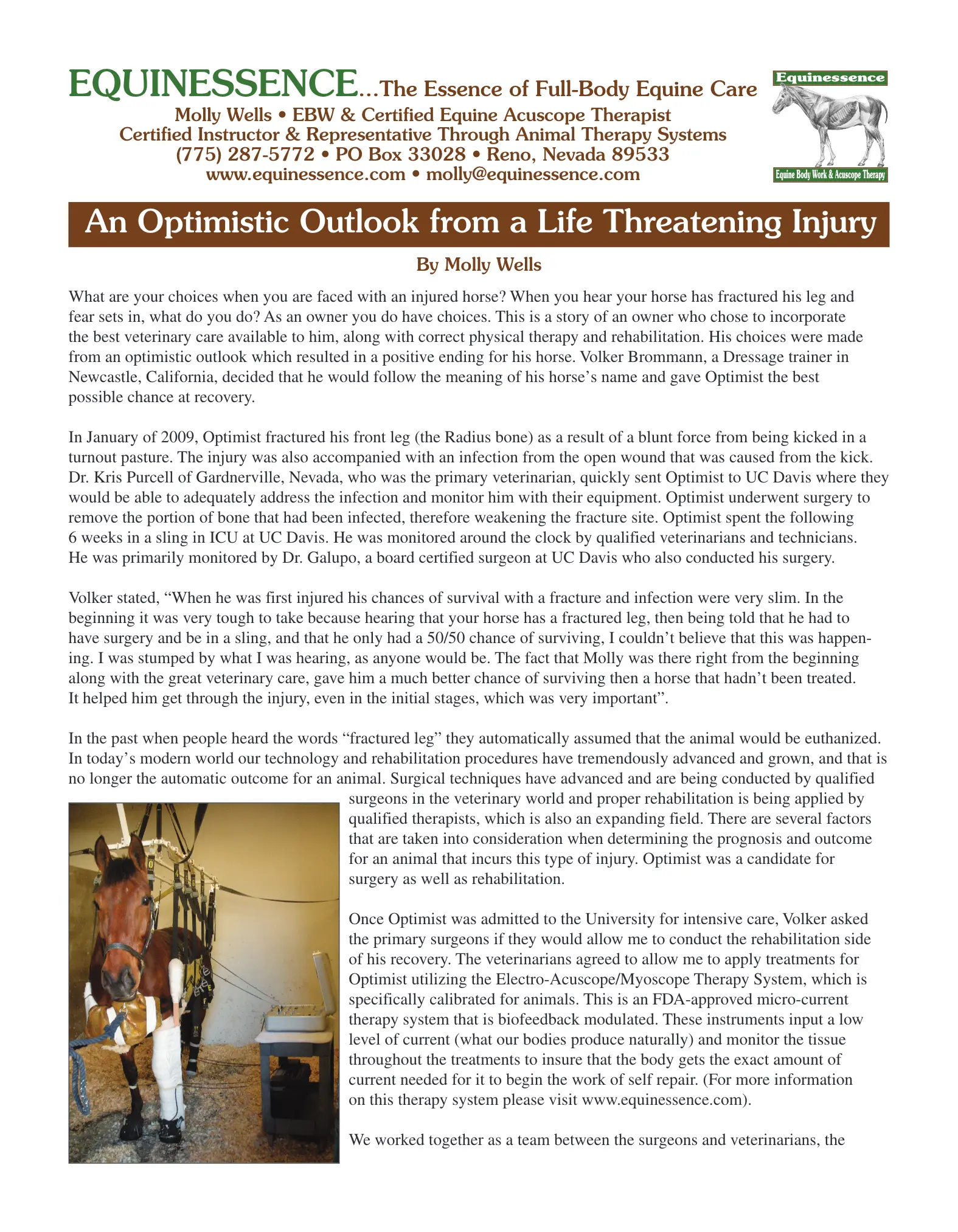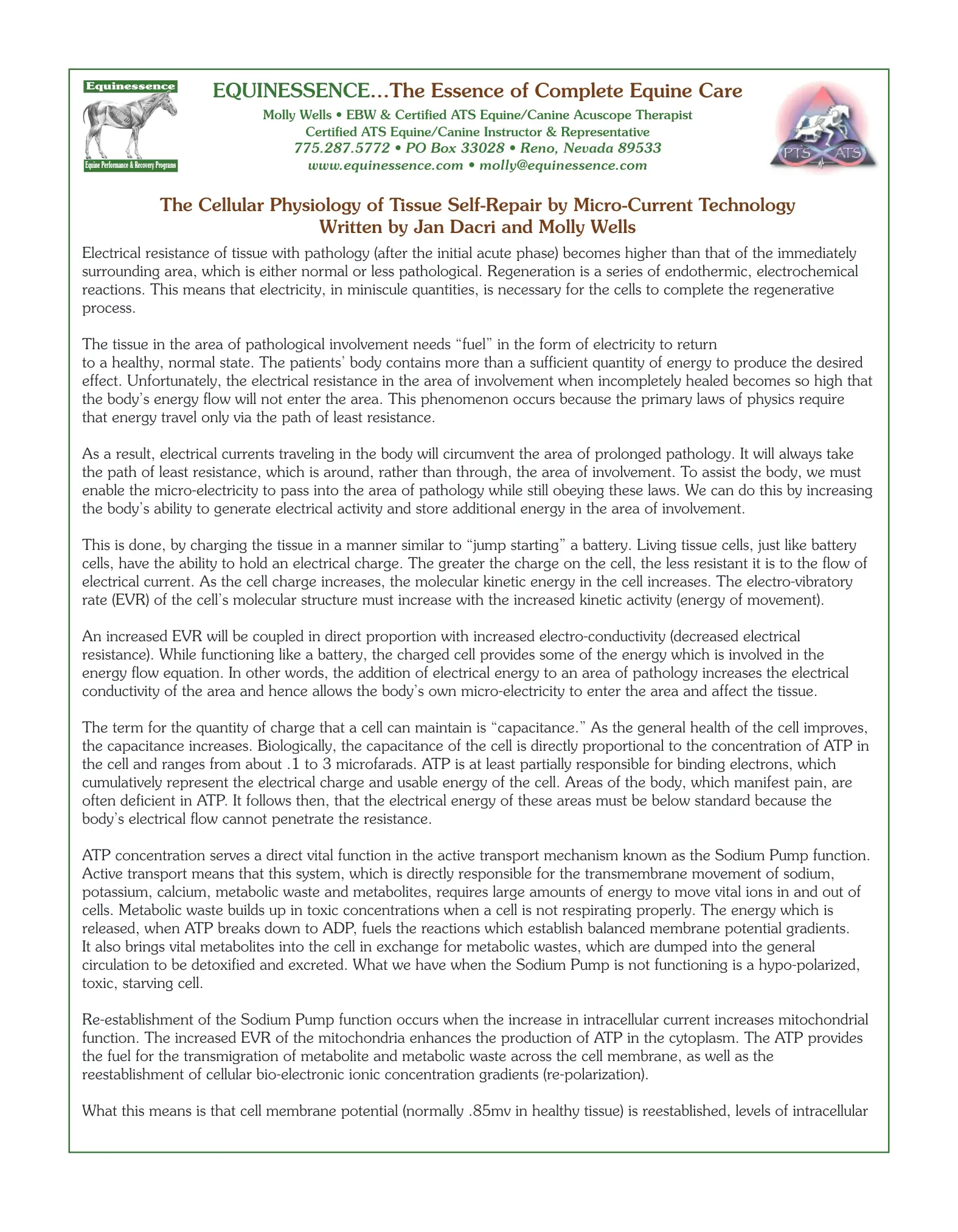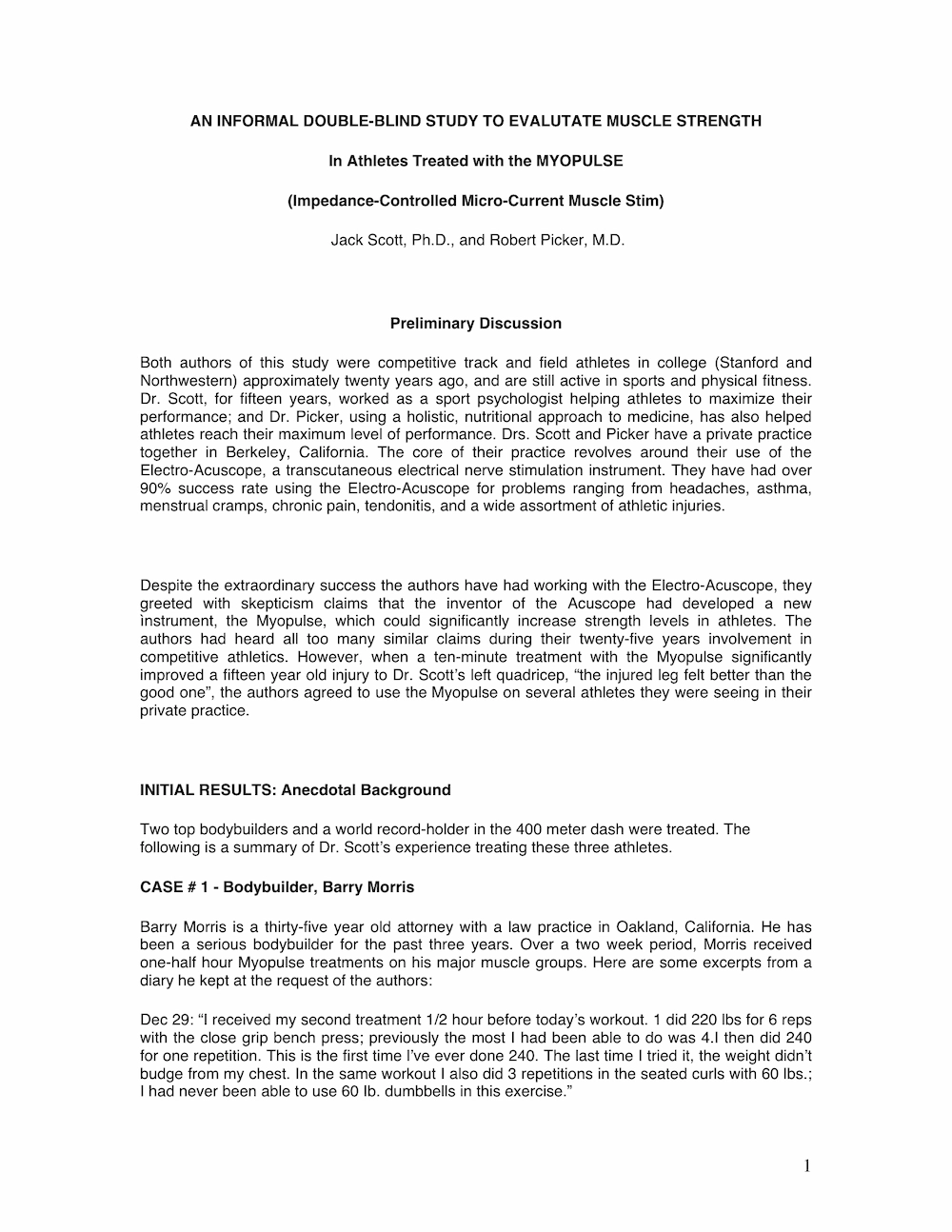Technical Information
The Electro-Acuscope/Myopulse Therapy System
The Electro-Acuscope and Electro-Myopulse are unique, sophisticated, FDA approved instruments that interface micro-current with living bio-electricity. The technology incorporates biofeedback monitoring and computer-chip circuitry programming. Reading impedance and resistance (the capacity of tissue to conduct signals) and its ability to "hold a charge," the biofeedback enables the computer program to calculate the corrective output (waveforms and frequencies). It can locate areas where the electrical patterns are abnormal (too high with acute inflammation, or too low where there is a depletion of energy) and introduces the appropriate amount of low level electrical current into the cells. Treatment continues until a state of normal, healthy, undisrupted conductivity is restored. When this happens the healing process is accelerated, pain disappears, and normal range of motions returns. This technology offers the opportunity to assist the body in its innate ability to self-repair.
Electro-Acuscope
The Electro-Acuscope is an electrotherapeutic micro-current instrument which acts upon subcutaneous tissues to help reduce pain and inflammation. It may also improve blood flow in circulatory-impaired tissues. Many types of tissue cells have membranes with ion channels that are voltage-sensitive. Electrotherapeutic currents can increase the entrance of substance such as, calcium ions which turn on repair mechanisms within those cells. Sensory nerve endings, for instance, release vasoactive peptides in response to the entrance of calcium. The Electro-Acuscope monitors the electrical conductivity and impedance of the tissue, and also can compute important electrical characteristics of the tissue from the current and voltage pulses themselves. Using this information, it adjusts the shape of those current and voltage pulses in order to optimize the effectiveness of the treatment. The output pulses of the Electro-Acuscope are neither constant-current nor constant-voltage during their duration, but are between the two modality limits.
Electro-Myopulse
The Myopulse is the companion instrument to the Acuscope and is designed to treat connective tissue associated primarily with muscle. The amplitudes of the current and voltage pulses continuously vary within a "sinusoidal modulation envelope." It is well established that the membrane of each muscle fiber contains voltage-controlled calcium ion channels. Much of the effectiveness of the Myopulse instrument appears to be due to the modest increases in internal calcium which, though inadequate to cause muscle contraction, could still result in increased ATP production and protein synthesis in order to prevent atrophy, accelerate tissue repair, and alleviate pain. (It would not be desirable to induce muscle contraction in the manner of conventional muscle stimulators because this would use up ATP which could be put to better use as an energy source for synthesizing new cellular repair molecules). Since the current and voltage pulses have constant varying amplitudes over the four-second period of each modulation envelope cycle, some impulses will be optimal for each portion of the three-dimensional current field (even to considerable depth into the tissue). Some of the current pulses will have an initial current overshoot portion that can open higher threshold ion channels especially in regions of the current field that are closer to the electrodes. In addition to monitoring the current waveform if each pulse, the Myopulse instrument also has special current and voltage monitoring impulses to provide tissue impedance information.
Micro-Current Technology
Electrical resistance of tissue with pathology (after the initial acute phase) becomes higher than that of the immediately surrounding area, which is either normal or less pathological. Regeneration is a series of endothermic, electrochemical reactions. This means that electricity, in minuscule quantities, is necessary for the cells to complete regenerative process.
As a result, electrical currents traveling in the body circumvent the area of prolonged pathology. It will always take the path of least resistance, which is around, rather than through, the area of involvement. To assist the body, we must enable the micro-electricity to pass into the area of pathology while still obeying these laws. We can do this by increasing the body’s ability to generate electrical activity and store additional energy in the area of involvement.
This is done, by charging the tissue in a manner similar to “jump starting” a battery. Living tissue cells, just like battery cells, have the ability to hold an electrical charge, the greater the charge on the cell, the less resistant it is to the flow of electrical current, as the cell charge increases, the molecular kinetic energy in the cell increases. The electro-vibratory rate (EVR) of the cell’s molecular structure must increase with the increase kinetic activity (energy of movement).
An increased EVR will be coupled in direct proportion with increased electro-conductivity (decreased electrical resistance). While functioning like a battery, the charged cell provides some of the energy which is involved in the energy flow equation. In other words, the addition of electrical energy to an area of pathology increases the electrical conductivity of the area and hence allows the body’s own micro-electricity to enter the area and affect the tissue.
The term for the quantity of charge that a cell can maintain is “capacitance.” As the general health of the cell improves, the capacitance increase. Biological, the capacitance of the cell is directly proportional to the concentration of ATP in the cell and ranges from about .1 to 3 microfarads.
ATP is at least partially responsible for binding electrons, which cumulatively represent the electrical charge and usable energy of the cell. Areas of the body, which manifest pain, are often deficient in ATP. It follows then, that the electrical energy of those areas must be below standard because the body’s electrical flow cannot penetrate the resistance.
ATP concentration serves a direct vital function in the active transport mechanism known as the Sodium Pump function. Active transport means that this system, which is directly responsible for the trans membrane movement of sodium, potassium, calcium, metabolic waste and metabolites, requires large amounts of energy to move vital ions in and out of cells. Metabolic waste builds up in toxic concentrations when a cell is not respirating properly. The energy which is released when ATP breaks down to ADP fuels the reactions, which establish balanced membrane potential gradients. It also brings vital metabolites in the cell in exchange for metabolic wastes, which are dumped into the general circulation to be detoxified and excreted. What we have when the Sodium Pump is not functioning is a hypo-polarized toxic, starving cell.
Re-establishment of the Sodium Pump occurs when the increase in intracellular current increased mitochondrial function. The increased EVR of the mitochondria enhances the production of ATP in the cytoplasm. The ATP provides the fuel for the transmigration of metabolite and metabolic waste across the cell membrane, as well as the reestablishment of cellular bio-electronic ionic concentration gradients (re-polarization). What this means is that cell membrane potential (normally .85mv in healthy tissue) is reestablished, levels of intracellular metabolic waste (i.e. lactic acid, etc.) are reduced and fresh concentrations of usable cellular metabolites are introduced into the exhausted cell. At this point the cell can enter its regenerative phase, pain levels are noticeably reduced and tissue regeneration functions are reestablished.
The investigations of living cells based on electrical concepts and using electrical techniques have been amazingly successful. For over a half-century the membranes of cells have been researched and described. In 1991, two German scientists won the Nobel Prize for their Cell Channel findings. Their research, particularly the development technique called the “patch clamp,” which allows the detection of electrical currents of a trillionth of an ampere in the membrane, or surface of a cell, has revolutionized modern biology.
The electrical parameters of cellular metabolism are well known facts and include: resting potential capacitance, resistance, conductance, impedance, polarization, current density, inductive reactance and electrical phase angle, to name a few common terms.
According to Biophysicist Mark Biedebach, Ph.D., if the integrity of the epidermal tissue is broken by a wound, there will be a net flow of ionic current through the low resistance pathway of the injured cells and the fluid exudes which lines the wound. Therefore, it is tempting to hypothesize that the ionic current flow pattern between normal and insulated tissue to a normal functional state. It follows logically that the rates at which these processes occur may be accelerated by judicious imposition of an electric current from an outside source.
Cellular physiologists are now recognizing that stimuli which activate the most energy-requiring processes within cells do so via an increase in intracellular calcium. An increase in intracellular calcium following membrane depolarization occurs because: 1) voltage sensitive Ca channels allow extracellular Ca to enter 2) current entering the cells can cause Ca release from cellular organelles.
Biedebach suggests that the best way to alleviate pain and inflammation would be to accelerate the rate of repair of the damaged tissue cell membranes that are responsible for releasing pain-producing substances. Damaged plasma membranes release arachidonic acid, a component of the phospholipid structure of the membrane itself. From this, prostaglandins are synthesized, triggering a cascade of reactions resulting in the release of histamine and bradykinins. This can stimulate pain endings as well as partakes in the inflammatory response.
Current that does eventually enter a cell alters the cell membranes’ voltage in such a way that it allows influx of ions, which can turn on and accelerate biochemical processes, essential to cellular repair. If we used only DC current, the intracellular current would flow only through discrete pores or ion channels, through a low resistance pathway called tight junctions, if we used pulsed current, there will be an additional pathway for current to enter a cell through membrane capacitance. Current flow through this additional pathway increases the ratio of intracellular to extra-cellular current flow, making the current more effective.
Pulsed current with a rapid voltage rise-time is more effective because: 1) pulsed voltage must rise to its maximum value before membrane capacitance has had time to “charge up.” The time it takes for membrane capacitance to charge up is a fraction of a millisecond. Therefore, it is desirable for the loaded stimulus pulse voltage to rise to its maximum in 50 microseconds or less. 2) Voltage sensitive Na and Ca channels stay open only (0.5) milliseconds after they have been opened, and they don’t reopen for a brief time following closure. The stimulus pulse needs to stay on long enough so that cell membrane capacitance can charge to its maximum value before the pulse turns off. Therefore, duration should last several milliseconds to meet known cellular time constraints. There parameters are appropriately delivered by the Electro-Acuscope and Myopulse.
Scientific Literature
Below are several informative pieces of literature and studies to help further your knowledge about the Electro-Acuscope/Myopulse Therapy System.




